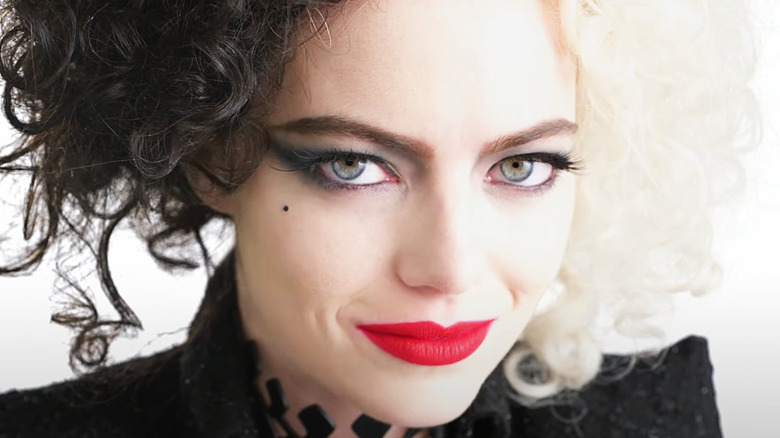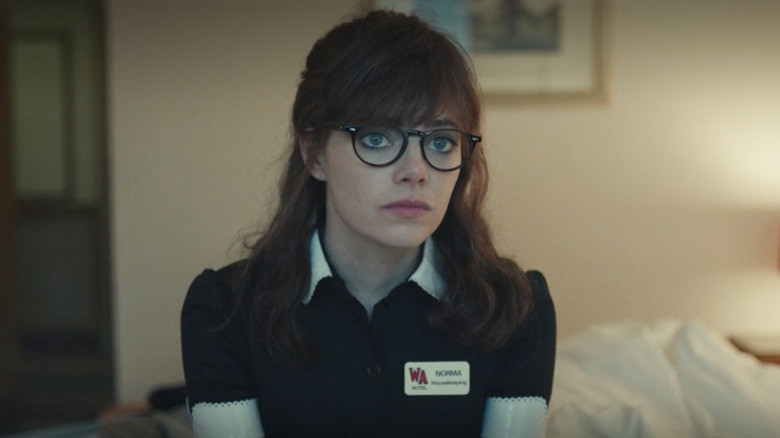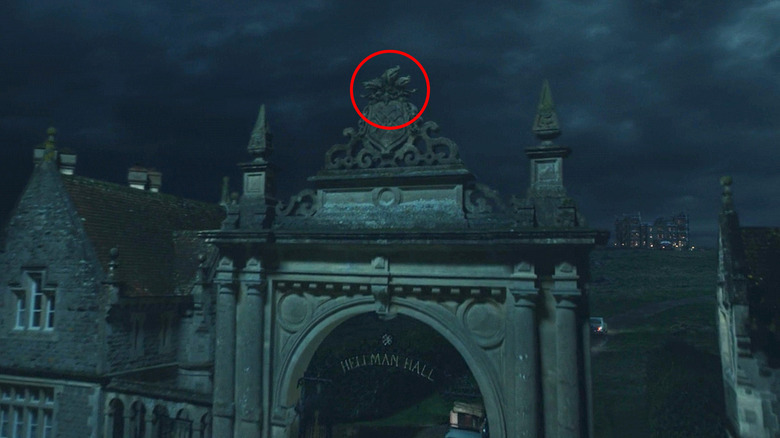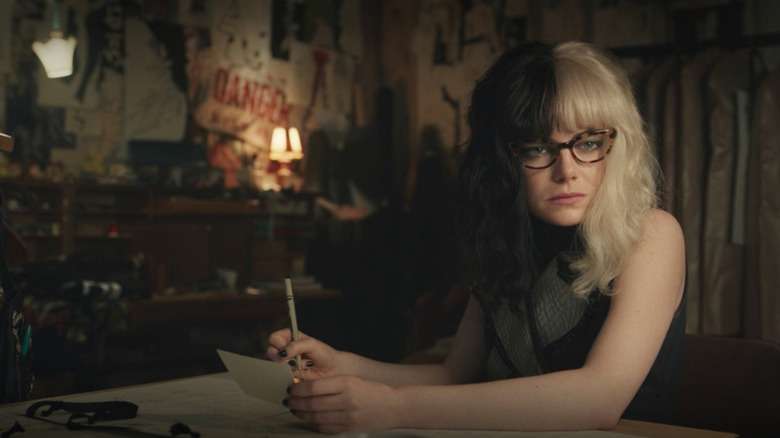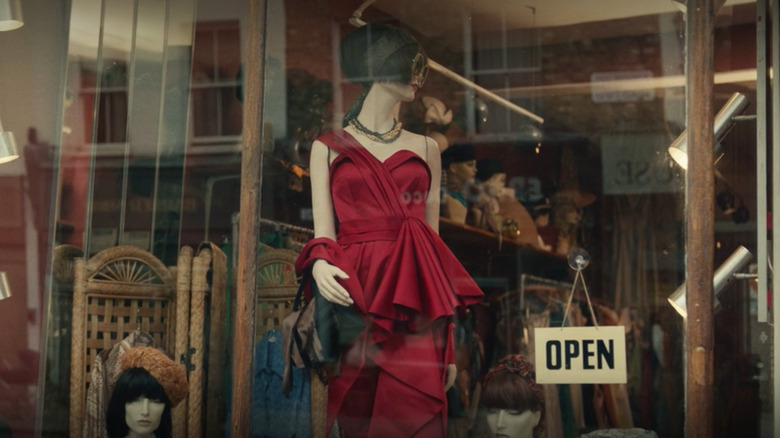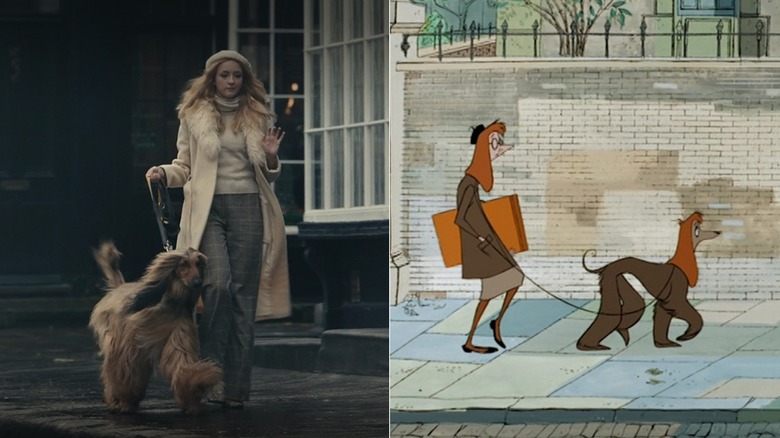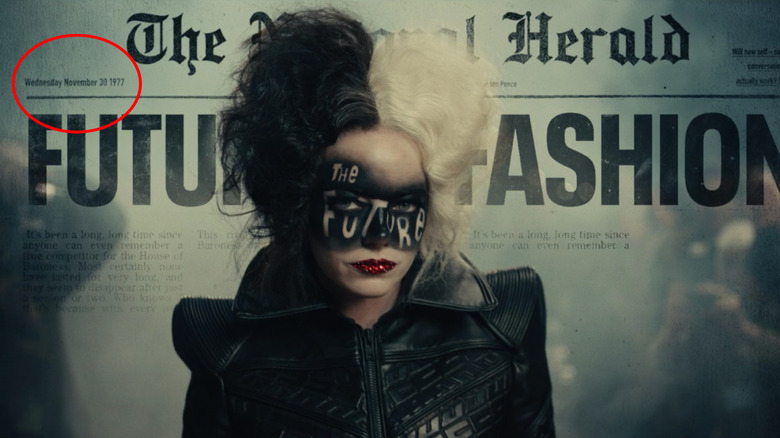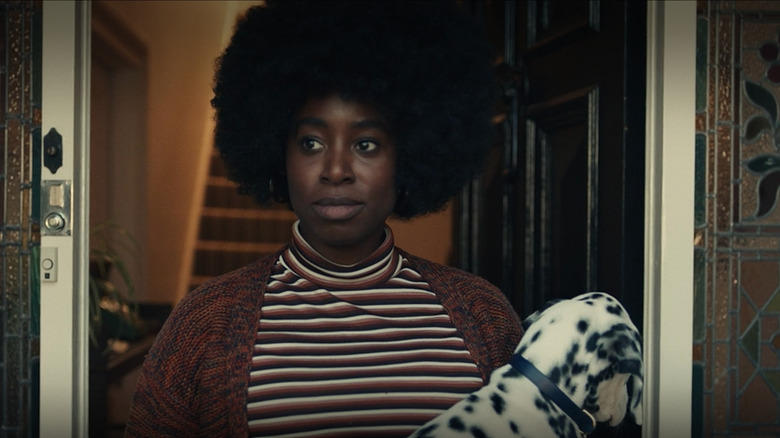Small Details You Missed In Cruella
Contains spoilers for the "Cruella"
The live-action prequel to the 1961 animated film "One Hundred and One Dalmatians," Disney's latest release "Cruella" stars Emma Stone as Estella, an orphan pickpocket in London with dreams of becoming a fashion designer. Prominent fashion icon Baroness Von Hellman (Emma Thompson) eventually notices Estella's talents, and promptly hires her to work at her fashion house. However, after learning that the Baroness murdered Estella's mother, Estella vows to exact revenge on her new employer. In her scheming, Estella creates an alter ego named Cruella to publicly embarrass the Baroness by night, while Estella internally sabotages the company by day. And in a third-act twist, it's revealed that — gasp! — the Baroness is Estella's real birth mother.
Say what you will about the plot, but "Cruella" is an undeniable visual spectacle. According to Variety, the film's costume designer Jenny Beavan and her team created 47 looks for Cruella, and 33 for the Baroness. The flamboyant outfits and set designs are so eye-catching, in fact, that they could easily distract you from all the little subtleties presented. From references to the original animated feature to clues that foreshadow larger themes, "Cruella" is full of hidden details. Let's break them down.
Hitchcockian hints about Estella's future emotional upheaval
Toward the beginning of the film, while posing as a maid to rob hotels, Estella gets distracted and watches a scene from an old film playing on the television. The movie is Alfred Hitchcock's "Lifeboat," about a group of people stranded in the middle of the ocean awaiting rescue. The scene highlights actress Tallulah Bankhead in her role as Constance, bursting into a fit of hysterical laughter after losing everything she valued in life. It's a haunting laugh, full of desperation and madness — the same kind of feelings Estella will be hit with later on. Fittingly, Disney animator Marc Davis said in an interview with the Los Angeles Times that Bankhead was actually one of his inspirations when he was creating the original Cruella.
As she watches the scene, Estella is also wearing a name tag that reads "Norma." This references another Hitchcock character from the movie "Psycho." Norma, who's heard but not seen in the movie, is the domineering mother of Norman Bates; her influence on her son causes him to develop a murderous alter ego. The quick flash of the "Norma" name tag seemingly foreshadows Estella's fate, as she allows her desire for vengeance to become all-consuming. Though Estella doesn't become a killer like Norman Bates, her Cruella persona overwhelms her true identity and jeopardizes her sanity, similar to how Norman's murderous ways overtake him.
Estella's breakdown parallels the delirium that consumes Constance in "Lifeboat." As Estella reflects on her state of mind towards the end of "Cruella," she admits to her friends, "I went a bit mad."
More to the Dalmatians than meets the eye
As events unfold, it's revealed that Estella's hatred of Dalmatians stems from witnessing three canines push her mother off a cliff to her death. Even prior to this event, though, black spots are a constant nuisance in Estella's life. We see her splattered with blobs of black ink at school, and her headmaster fills her school report with black dots to mark her demerits before finally expelling her from school. Talk about a bad omen!
The three Dalmatians in "Cruella" are also referential to the Greek myth of Cerberus, a three-headed dog that guards the gates of the underworld. The entryway of the Baroness' manor, appropriately named Hellman Hall, briefly shows a carving of three dog heads. This motif, seen at the top of the home's entrance, reinforces the Greek legend. Additionally, during "Cruella," we learn the name of only one of the three Dalmatians: Genghis. This is evidently a nod to Genghis Khan, a historical figure famed for his savagery and ruthlessness in battle, makes the animals even more menacing.
All these elements foreshadow both the hounds' hellish nature and Estella's future relationship with the breed.
Estella's collage
In the movie, the walls in Estella's room are covered in a collage of clips, cards, swatches, and sketches. We can see numerous gown ideas that Estella has drafted, as well as a range of other images and articles related to fashion. In one magazine cutout, we clearly see the title "The New Word of Mouth," which was a genuine feature that ran in the April 1966 issue of UK Vogue. Another article clipping holds the headline "Genius Show From House of Baroness," and is accompanied by a picture of Baroness von Hellman. Later, when Estella first arrives as the Baroness' newest employee, the fashion house head reads aloud from that same article as her entire staff listens.
As the movie progresses and Estella begins to morph into Cruella, her collage of fashion also changes, adding more red-colored pieces and clippings. When her friend Jasper (Joel Fry) tries to broach the subject of her radical transformation, Estella dismisses the conversation and walks away. She goes up to the collage and stands next to a red "Danger: Keep Away" sign while he tries to reason with her. This is a clear visual indicator of Cruella's hazardous state of mind, and a sign that her risky behavior is putting everyone around her in jeopardy.
The red dress, and the winter ball of 1965
It's the winter of 1965 when Estella's (adoptive) mother Catherine (Emily Beecham) goes to speak to the Baroness and is subsequently murdered. We know this is the exact season and year because the date on Catherine's car registration sticker as she drives up to the mansion says "December 1965." Unaware of her true identity, the Baroness recounts the story to Estella years later, saying, "It was during my winter ball, and her death really overshadowed the whole thing." This confirm that the lavish party seen earlier in the film was thrown to celebrate the success of the Baroness' winter 1965 fashion line.
Another nod to the same night is a card from the House of Baroness, pasted in the middle of Estella's collage, commemorating that year's collection. It reads, "House of Baroness, Winter Collection 1965," with the image of an asymmetrical ruffled red gown beside the text. Estella later sees this exact same red dress in the window of a boutique store, and she promptly goes in to investigate. When she enters, the store's proprietor Artie (John McCrie) confirms that it's "Baroness '65 in the window — winter collection."
Afterwards, when our protagonist's alter ego Cruella crashes the Black and White Ball and sets her white cloak aflame to reveal the bright red gown underneath, it's the same dress from the Baroness' 1965 collection, only altered. When the Baroness inquires who designed the clothing, Cruella replies, "You did actually. 1965 collection — I fixed it."
Paying homage to One Hundred and One Dalmatians
Throughout "Cruella," there are several callbacks and references to the original 1961 animated feature "One Hundred and One Dalmatians."
For starters, Estella has a schoolmate named Anita Darling (Kirby Howell-Baptiste). Her first name is, obviously, a nod to Anita Radcliffe from the 1961 flick — but her full name is a reference to the movie as well: It's the first thing Cruella de Vil says in the movie. Upon entering the Radcliffes' house, Cruella exclaims, "Anita, darling!" In the book upon which "One Hundred and One Dalmatians" is based (Dodie Smith's "The Hundred and One Dalmatians"), the 1996 live-action movie, and "101 Dalmatians: The Series," Anita's last name is Dearly. Even though "Cruella" changed Anita's surname, the filmmakers still made sure the change was a meaningful one.
Another callback happens when Horace (Paul Walter Hauser) sees a woman walking her Afghan Hound and asks Jasper whether he's ever noticed that people tend to look like their dogs. This is a direct reference to the first scene of "One Hundred and One Dalmatians," where people walking with their dogs bear a striking resemblance to their pets. One of the dog-walkers is a woman dressed in brown who's walking her Afghan Hound, exactly like the woman Horace sees in "Cruella."
Additionally, the car that Cruella steals in this movie is the same model that Cruella drives in both the animated movie and the 1996 live-action film starring Glenn Close. Specifically, it's a Panther De Ville, and serves as an inspiration for Cruella in choosing her last name "de Vil." She even has "DEVIL" vanity plates on the car at the end of the movie — not unlike her birth mother Baroness von Hellman, whose license plates read "1 BVH."
Dates, dates, dates
Although it's never stated plainly, Estella's real last name is Miller, as seen on the Liberty London employment letter Jasper gives her for her birthday. When her birth certificate is revealed, we learn that her actual name (including a title) is "the Honorable Estella von Hellman." The certificate also includes her birthday as August 7, 1952. Since the majority of the movie takes place in is 1977 — also seen in the dated employment letter – that means Estella just celebrated her 25th birthday.
Other moments and written information help offer a clearer timeline of events. Thanks to her birthdate, we know Estella was 12 years old when she began attending private school, getting expelled after just one year. We also know from the newspaper headlines splashed on screen that Cruella begins to upstage the Baroness on November 30, 1977 — meaning she'd been employed at the fashion house for fewer than 4 months before she starts wreaking havoc.
And although the House of Baroness may not be a real-life fashion house, the Liberty London department store, which initially employs Estella, is completely genuine and has been in business since 1875 (via House Beautiful).
The final scene of Cruella
The last scene of "Cruella" sets up the elements for the beginning of the "One Hundred and One Dalmatians" film. At the end, Cruella gifts Anita and the Baroness' lawyer Roger (Kayvan Novak) one Dalmatian puppy each. The boxes they come in declare their names to be Pongo and Perdita, which are the names of the puppies in the original story. Additionally, Cruella and Anita are "former schoolmates" in the original film, and the one year they spent together before Cruella's expulsion does make that statement technically true.
The ending of "Cruella" also lays the foundation for Roger's future antagonism towards Cruella by adding the narration, "Roger always blamed me for getting him fired." As the credits roll, we hear Roger sing the original Cruella de Vil song written by Melville Levin. Roger's apartment in "Cruella" is also an impressive duplicate of the bachelor pad Roger inhabits in the animated movie from 1961. It features a disarray of bookshelves, a cello, and a clock above the fireplace covered by a hat, exactly as seen in the '60s film.
As to the logic of why Cruella would one day try to skin the puppies that she gifted to her friends — especially given that she appears to enjoy the company of all dogs at the end of the movie — it's anyone's guess.
"Cruella" is available to stream on Disney+ with Premier Access now.
